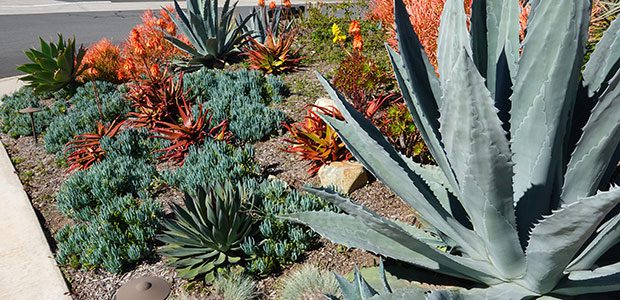Summer Irrigation
During the hot summer months we adjust our habits, activities, and how much water we consume. We should also be changing how we care for our landscape plants during these hot summer months.
Cacti native to Arizona need almost no supplemental irrigation. When frequently watered, the roots of cacti can rot, killing the entire plant. Also, a saguaro that is watered will be constantly bloated which causes fissures to devel-op in its accordion like folds. These injuries can lead to disease that may eventually kill the plant.
If there has been a month of temperatures exceeding 105 degrees with no rain then a cactus will need some water. A thirsty cactus can be easily identified because it gets very skinny. In this case, give the plant a good, deep soak with the hose and it will be ready for another month of the same weather. Sprinkler heads that attach to the end of a hose work will for cactus patches. Cacti not native to Arizona might need more watering.
Native shrubs need to be watered weekly during the summer. To achieve maximum growth, give native plants fertilizer in the spring. You may choose to feed monthly from May to September with an all-purpose, water-soluble fertilizer diluted to half-strength. Established native trees should not have a need to be watered when surrounded by shrubs with irrigation. They will be able to get the needed moisture from the surrounding irrigation.
Ornamental trees will need to have a regular schedule of watering. With all plants, make sure they are being irrigated out where the feeder roots are, not by the trunk.
Citrus like to dry out between watering. In the hottest part of summer citrus trees need to be watered once every one to two weeks depending on soil type. When watering citrus it is best to flood them for a deep soaking. Water frequency should be reduced as temperatures drop over the winter. Give the tree time to adjust to the new water schedule by lowering the water frequency over time.
Newly planted trees need more frequent watering. For the first two week after planting, water every one to three days depending on soil drainage. Then slowly cut back on the water frequency to establish deep, strong roots. Examples of other plants that fall under this schedule are Bougainvilleas and Oleanders. Interestingly, established oleanders need even less water. They are almost a tough as cactus, which is surprising considering how lush they look.
And of course don’t forget the monsoon season is arriving soon. It is notorious for its high winds ripping branches off trees or completely uprooting them altogether. Protect your trees by removing weak and crossing branches. Thin up to 25 percent of the canopy so wind can move through the branches. Chilean Mesquites are particularly susceptible to monsoon damage. Don’t water them any more than they absolutely need. High winds and wet soils result in fallen trees.








